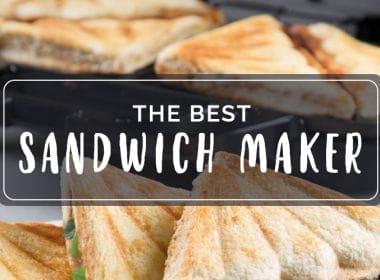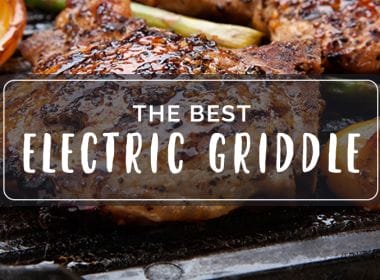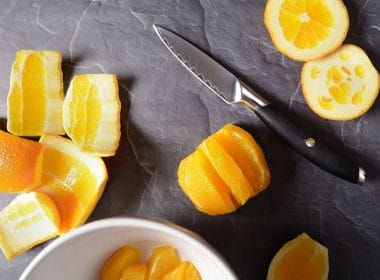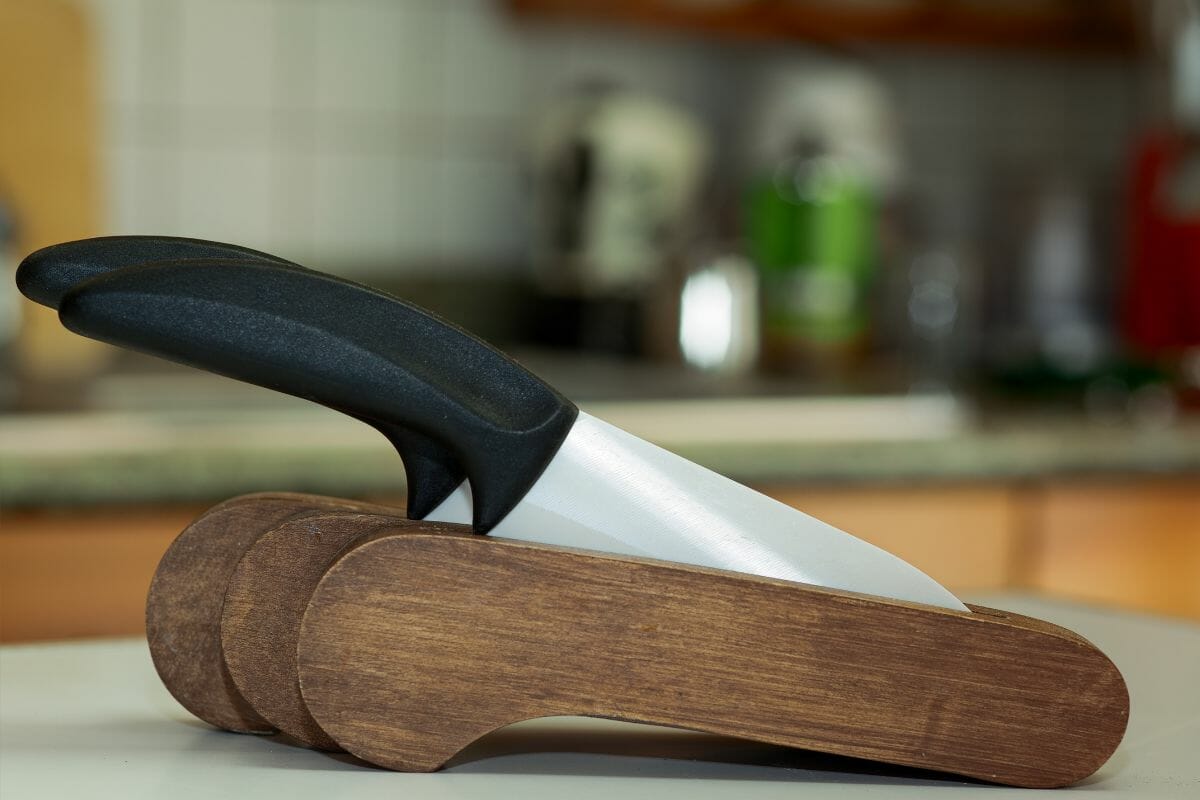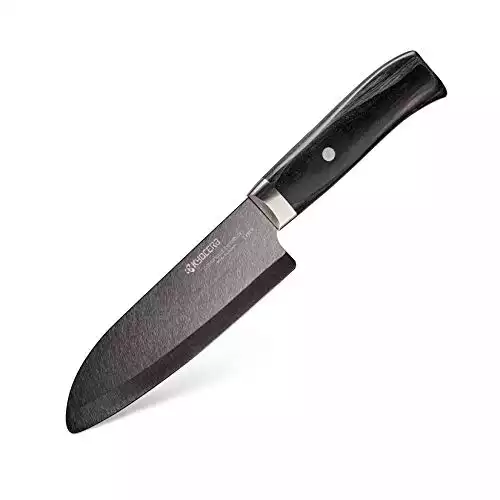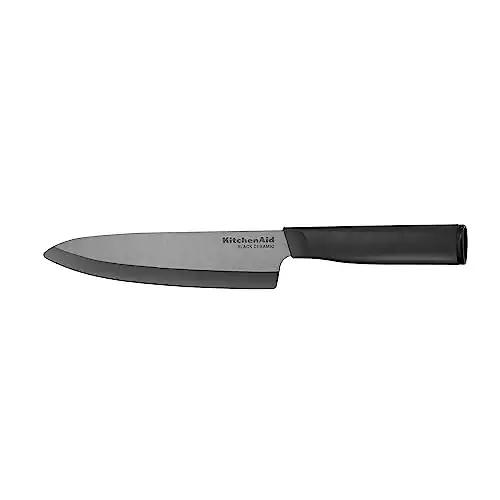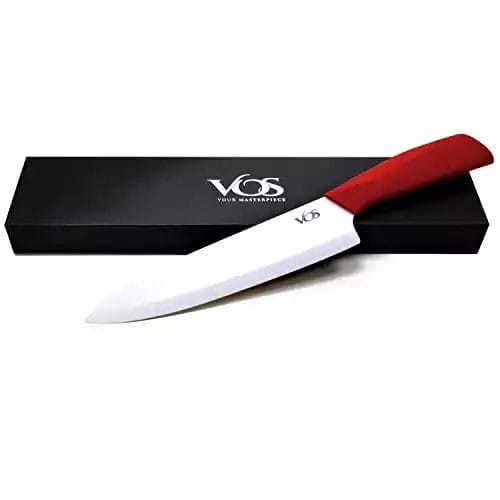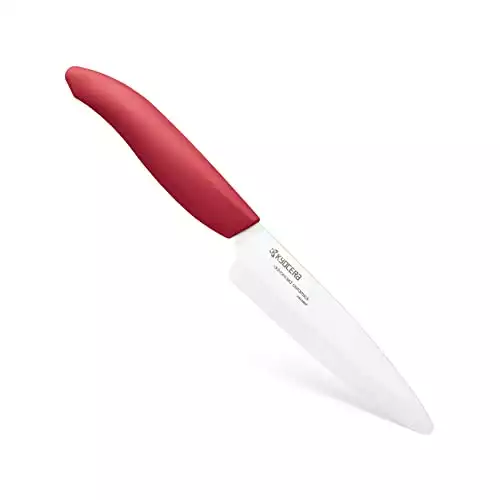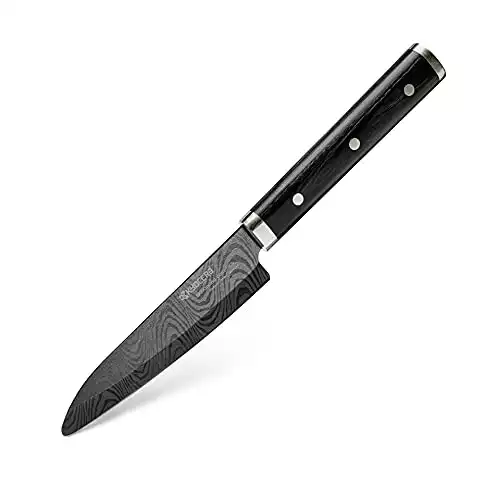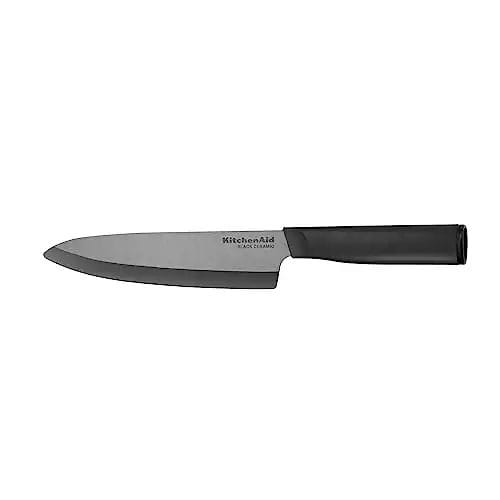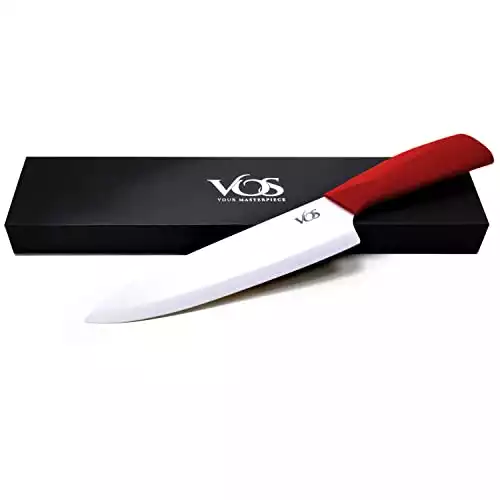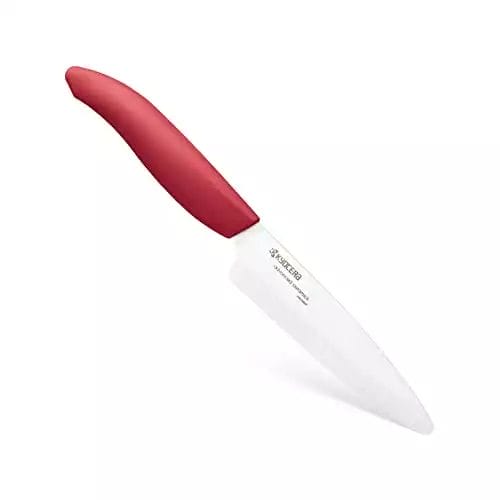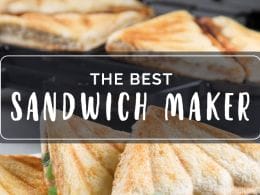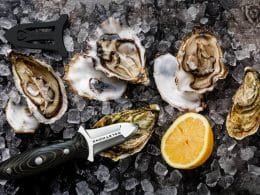I think we can all agree that steel knives are absolutely fantastic, but they’re not suited to every kitchen task, and it would be unfair to put such a burden on them.
Sure, steel is tough, but it’s not invincible, and certain culinary endeavors can leave them looking a little worse for wear.
The more traditional steel blades deteriorate, the more dangerous they become, potentially leading to some pretty painful kitchen accidents.
Having worked as a chef for over 10 years, I have seen my fair share of knife-related horrors, but is there a way to avoid such bloody mishaps?
Yep, absolutely!
Ceramic knives are there to do all the jobs your steel blades hate, and if a task is easier for a knife, it’s a darn sight easier for you too.
So, without further ado, let’s check out the best ceramic knives on the market.
Table of Contents
- Best Ceramic Knives: Reviews
- Editor’s Pick — Kyocera Advanced Ceramic LTD Series Santoku Knife
- Premium Option — Kyocera Premier Elite Ceramic Utility Knife
- Best On A Budget — KitchenAid Classic Ceramic Knife
- Best For Big Tasks — Vos Ceramic Chef Knife
- Best For Intricate Tasks — Kyocera Advanced Ceramic Revolution Series Utility Knife
- Buyer’s Guide
- Frequently Asked Questions
- Final Thoughts
Best Ceramic Knives: Reviews
Editor’s Pick — Kyocera Advanced Ceramic LTD Series Santoku Knife
For a blade that cuts a seamless balance between quality and value for money, there’s really no substitute for the Kyocera Advanced Santoku Knife, and, to sweeten the deal, it’s a stunning design.
Crafted using Kyocera’s proprietary augmented zirconia, the black blade can be sharpened to a minute edge, and during my tests (over the course of a couple of months), I didn’t have to sharpen it once — The retention was next level!
The handle is handcrafted pakka wood, a dark, durable wood composite famous for its density and color fast properties, meaning this knife offers you the classy wooden aesthetic without the limited lifespan, so it’s a win-win in my eyes.
Only a single steel rivet is used in order to provide excellent stability without increasing the handle weight too much, amounting to an exceedingly well balanced blade, and, at 5.5”, it’s about as universal as a kitchen knife can be.
This one blade will handle almost as much as a full set of ceramic knives!
PROS
- Proprietary blade — Kyocera have used their special formula to make the blade sharp and resilient
- 5.5” — Can handle the big stuff and a lot of the small stuff
- Pakka wood handle — Both attractive and durable
- Single steel rivet — Very secure and lightweight
CONS
- Size — A little too short for slicing large veggies in half
Premium Option — Kyocera Premier Elite Ceramic Utility Knife
While there are a few minor differences in build, the same high quality materials used to forge the santoku knife reviewed above have been used to create this premium Kyocera blade.
The hand-crafted pakku wood handle is lovely to grip tightly for heavier tasks and loosely for more delicate work, but this time around there are three steel rivets, for even more stability.
The blade itself is also a very different, more agile shape, which I find makes nuanced kitchen work a lot easier.
But perhaps my favorite thing about this Elite knife during my tests was the rounded tip.
Without a sharp point, there’s very little chance of it breaking should you accidentally drag the knife off the edge of the chopping board during use.
This drawback is that it’s not great for stabbing jobs such as opening packaging or preparing jacket potatoes, but ideally, you’ll be using a different blade for this kind of thing anyway.
PROS
- Hot-isostatic blade formation — Incredibly hard, sharp blade
- Triple rivet — Stability for decades
Rounded tip — Less chance of a breakage - Pakka wood handle — Attractive and durable
- Etched blade — It looks amazing!
CONS
- Price tag — Maybe more than you’re willing to spend on one knife
- No point — Can’t poke through things
Best On A Budget — KitchenAid Classic Ceramic Knife
You really don’t have to spend a fortune to bring home a relatively capable ceramic blade, as evidenced by this amazing KitchenAid Classic ceramic chef knife.
Granted, there’s nothing fancy going on — the handle is plastic, and the blade isn’t as pretty as the Kyocera knives — but it’s sharp, durable, and made of relatively high-quality zirconia.
Although it’s a cheap, synthetic handle, as far as shaping goes, I have very little to complain about.
It’s comfortable in hand for most jobs; however, as it’s glued on, I do question how many years it would remain stable.
Still, at this price point, you shouldn’t expect it to be passed down in your family as an heirloom.
The balance is surprisingly great, and as it’s available in multiple sizes, you can pick out the one that’s going to be most useful for you.
I found I had to sharpen it a couple of times during my testing, but with some steady maintenance, there’s no reason this blade can’t have a hugely positive impact on your kitchen work.
PROS
- Price — Ceramic excellence that won’t break the bank
- Nice and sharp out the box — Didn’t need sharpening right away
- Good balance — Facilitates good work
CONS
- Glued plastic handle — Not as hard wearing as a riveted blade
- Edge retention — You have to stay on top of maintenance to keep it sharp
Best For Big Tasks — Vos Ceramic Chef Knife
This 8” Vos ceramic knife is perfect for chopping all the larger fruit and veggies in your kitchen, especially seeing as the handle is one of the most ergonomic I’ve ever tested.
I was able to cut for literally hours with minimal hand fatigue, so if you prep a lot of food, this is the blade for you.
What’s more, as the handle features some soft touch grips, a drop is very unlikely, meaning this knife will live a very long and helpful life in your kitchen.
The blade itself is very sharp for the price, and I found the edge retention to be almost on par with much pricer knives.
Balance wise, I have no qualms. The handle is super light, so even though the blade too is featherweight, you always have that additional force for slicing challenging veggies such as swede.
PROS
- Price — Not bad for the quality
- Good balance — Makes chopping difficult veg easy
- Edge retention — Excellent for the price
- Handle — Not an expensive material but a very nice shape and the grip reduces the chances of a drop
CONS
- Handle fitting — Glued, as far as I could tell, so might not last decades
Best For Intricate Tasks — Kyocera Advanced Ceramic Revolution Series Utility Knife
Last but not least, we have another awesome Kyocera blade, but as a 4.5” blade with impeccable edge retention, it’s the ultimate tool for super intricate knife work.
The handle has been painstakingly shaped to reduce pressure on sensitive hand joints even after long days in the kitchen, and the sharpness out the box was incredible.
I think I’d have preferred a pakka wood handle, like the other Kyocera designs, but the synthetic handle is a worthy sacrifice considering you get Kyocera quality at this price point.
Similar to the Elite, it has that lovely rounded edge to reduce the chance of tip breakage, and during my tests, the non-stick edge was a godsend, especially when cutting carrots, as the disks fell straight onto the board rather than sticking to the knife then rolling onto the floor.
PROS
- Ergonomic handle — No hand fatigue!
- 4.5” — Perfect for intricate jobs
- Great balance — Designed for details
- Excellent edge retention — Less maintenance required to keep it in good working condition
CONS
- Plastic handle — Pakka wood is nicer to look at and feel
Buyer’s Guide
You may have a pretty good idea of what makes a good steel knife, and be completely lost when it comes to ceramics, but the good news is you’re looking for a lot of similar qualities.
Check them out in this buyer’s guide.
Size
The size of the blade dictates how it can be wielded — Different tasks require different size knives.
As you might assume, larger knives are better for slicing and dicing larger food items, but they can be quite cumbersome for the more nuanced tasks.
Generally speaking, an 8” knife is the most popular choice, as this is the size of a standard multi purpose chef’s knife, but for smaller, intricate jobs, 6” or smaller will be a better choice.
Handle Comfort
Of course, a multitude of factors contribute to the overall comfort of a knife, but here I’m referring to the ergonomics of the handle alone. The handle should feel completely effortless to hold.
There should be no edges that dig into your sensitive hand joints, and the surface should not cause too much friction as it shifts slightly in your hand while chopping.
Everyone’s hands are different, so there isn’t a one-size-fits-all answer to finding the best knife handle for you, so if possible, try a few different sizes and styles out and see what feels right.
Handle Quality
Comfort and quality often go hand in hand, but just to be sure, inspect the craftsmanship of the handle.
Is it fitted securely to the blade? Is it glued or injection molded?
If it’s glued, can you see any exposed adhesive? These are the questions you must ask yourself.
Handle Material
There are no real wrong answers when it comes to knife handles.
Wood handles look fantastic, and they never get too cold, which is a definite bonus if you live in a frosty climate.
However, they are harder to maintain.
Aluminum, on the other hand, is super lightweight, which lends itself to good balance in larger knives, and it’s durable too, but it can get a little cold during the winter months.
Steel is even more durable, but as it’s quite heavy, it might not be the best choice for medium-to-large knives.
Titanium combines the best qualities of both steel and aluminum, but it can be quite expensive.
Carbon fiber is better still, as it’s corrosion resistant, strong, lightweight, and insulates well, meaning it’s less likely to burn you if the blade gets hot.
Synthetic knives are also incredible, but sometimes they can be a sign that the knife as a whole isn’t made to the highest standard.
Ultimately, though, handle material is a matter of preference, and of course, budget.
A good knife is a good knife no matter what the handle is made of.
Balance
The ideal balance changes with each type of kitchen task, so first consider what you want to accomplish with your future ceramic knife.
For standard chopping tasks, the blade should be far heavier than the handle, but the more articulate the task becomes, the lighter the blade should be, with the handle outweighing it ever so slightly in order to give you as much control as possible.
Now let’s discuss the factors concerning ceramic blades specifically…
Edge Retention
Sharpness and edge retention is obviously a priority when shopping around for knives, and when it comes to ceramic blades, those made from high quality zirconia are the best of the best.
They’re extremely hard, and thus, can be sharpened to an exceedingly fine point.
Maintenance
Ceramics don’t rust — Woo! So you don’t have to worry about residual water on these blades, but they are incredibly brittle and must be used with great care.
I accidentally slid my ceramic off the edge of the chopping board onto the metal work surface during a cut, and although it was perhaps only a 1.5 cm drop, the blade’s tip cracked right off.
Frequently Asked Questions
Ceramic knives are absolutely made from ceramic, which isn’t to say they’re made of the same thing as your vases.
The term ceramic is actually an umbrella category that refers to any hard, brittle, heat- and corrosion-resistant inorganic material that’s been super heated to reach its optimal state.
There are a few different materials with these qualities, and they’re all considered ceramics.
The materials typically used to forge ceramic knives are zirconium oxide or an augmented form of zirconia.
Ceramic knives are not meant to entirely substitute a steel kitchen knife, but there are certain tasks that they’re better at, some of which can be quite damaging to steel knives.
As they’re much sharper and generally lighter, they’re fantastic for precise dicing and chopping, particularly when it comes to vegetables and fruit.
I’d always recommend using ceramic blades when cutting acidic fruit, as citrus can really do a number on steel.
Ceramic knives are not meant to entirely substitute a steel kitchen knife, but there are certain tasks that they’re better at, some of which can be quite damaging to steel knives.
As they’re much sharper and generally lighter, they’re fantastic for precise dicing and chopping, particularly when it comes to vegetables and fruit.
I’d always recommend using ceramic blades when cutting acidic fruit, as citrus can really do a number on steel.
Sharpening ceramic knives is possible, but as the materials used to forge the blades are so hard, you’ll need a very robust diamond sharpening tool to get the job done yourself.
Alternatively, you can send your ceramic knife off to be sharpened by a professional, but this is going to be both costly and time-consuming.
In most states, it’s illegal to carry a knife that cannot be flagged by a metal detector, which would include ceramic knives with wooden or synthetic handles, but it’s perfectly fine to have this kind of blade in your kitchen.
It’s not all that common, yet some professional chefs do use ceramic knives for certain tasks, but as the professional kitchen can get a little, shall we say… wild at times, it’s not always a good idea to have brittle material in the area.
This is why, generally speaking, no glasses are allowed in a commercial kitchen.
The answer here is a big, fat NO!!! Ceramic blades should never be placed in the dishwasher for cleaning.
Much like ceramic pans, ceramic knives arrive with a non-stick coating, and when exposed to the intense heat of a dishwasher’s cycle, this coat quickly dissipates, leaving the knife, by and large, ruined.
It’s very easy to chip a ceramic knife, as the blades are extremely hard and brittle, so it’s essential to use them with care and only for appropriate tasks with the right kind of equipment.
Final Thoughts
A ceramic knife can make your culinary life a whole lot easier, but not just any are going to cut the mustard (well… veg anyway), so do yourself a favor and pick one of my fantastic shortlisted blades.
I’ve tried my best to include a little something for everyone, no matter the budget or intended application.
All you need to do is use the buyer’s guide to help you decide which is the perfect one for you, then get slicing and dicing, ceramic-style!


